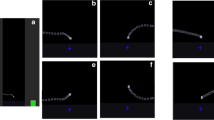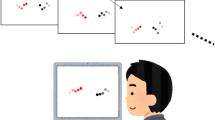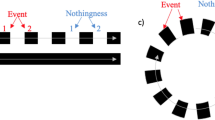Abstract
It has recently been suggested that time perception and motor timing are influenced by the presence of biological movements and animacy in the visual scene. Here, we investigated the interactions among timing, speed and animacy in two experiments. In Experiment 1, observers had to press a button in synchrony with the landing of a falling ball while a dancer or a whirligig moved in the background of the scene. The speed of these two characters was artificially changed across sessions. We found striking differences in the timing of button-press responses as a function of the condition. Responses were delayed considerably with increasing speed of the whirligig. By contrast, the effect of the dancer’s speed was weaker and in the opposite direction. In Experiment 2, we assessed the perceived animacy of these characters and found that the dancer was rated as much more animate than the whirligig, irrespective of the character speed. The results are consistent with the hypothesis that event timers are selectively biased as a function of perceived animacy, implicating high-level mechanisms for time modulation. However, response timing interacts with perceived animacy and speed in a complex manner.






Similar content being viewed by others
References
Bisio A, Stucchi N, Jacono M, Fadiga L, Pozzo T (2010) Automatic versus voluntary motor imitation: effect of visual context and stimulus velocity. PLoS ONE 5(10):e13506
Blake R, Shiffrar M (2007) Perception of human motion. Annu Rev Psychol 58:47–73
Bove M, Tacchino A, Pelosin E, Moisello C, Abbruzzese G, Ghilardi MF (2009) Spontaneous movement tempo is influenced by observation of rhythmical actions. Brain Res Bull 80:122–127
Brown SW (1995) Time, change, and motion: the effects of stimulus movement on temporal perception. Percept Psychophys 57(1):105–116
Carrozzo M, Moscatelli A, Lacquaniti F (2010) Tempo rubato: animacy speeds up time in the brain. PLoS ONE 5(12):e15638. doi:10.1371/journal.pone.0015638
Chang DH, Troje NF (2008) Perception of animacy and direction from local biological motion signals. J Vis 8(5):3, 1–10
Creelman CD (1962) Human discrimination of auditory duration. J Acoust Soc Am 34:528–593
Eagleman DM, Tse PU, Buonomano D, Janssen P, Nobre AC et al (2005) Time and the brain: how subjective time relates to neural time. J Neurosci 25:10369–10371
Fraisse P (1963) The psychology of time. Harper & Row, New York
Hammett ST, Champion RA, Morland AB, Thompson PG (2005) A ratio model of perceived speed in the human visual system. Proc R Soc B 272:2351–2356
Hietanen MA, Crowder NA, Ibbotson MR (2008) Differential changes in human perception of speed due to motion adaptation. J Vis 8(11):6, 1–10
Kanai R, Paffen CL, Hogendoorn H, Verstraten FA (2006) Time dilation in dynamic visual display. J Vis 6:1421–1430
Kaneko S, Murakami I (2009) Perceived duration of visual motion increases with speed. J Vis 9(7):14, 1–12
Lacquaniti F, Terzuolo C, Viviani P (1983) The law relating the kinematic and figural aspects of drawing movements. Acta Psychol (Amst) 54(1–3):115–130
Lhamon WT, Goldstone S (1974) Studies of auditory-visual differences in human time judgements. 2. More transmitted information with sounds than lights. Percept Mot Skills 39(1):295–307
Mauk MD, Buonomano DV (2004) The neural basis of temporal processing. Annu Rev Neurosci 27:307–340
Mouta S, Santos JA, Lopez-Moliner J (2012) The time to passage of biological and complex motion. J Vis 12(2):21, 1–14
Orgs G, Haggard P (2011) Temporal binding during apparent movement of the human body. Vis Cogn 19(7):833–845
Orgs G, Bestmann S, Schuur F, Haggard P (2011) From body form to biological motion: the apparent velocity of human movements biases subjective time. Psychol Sci 22(6):712–717
Rizzolatti G, Craighero L (2004) The mirror-neuron system. Annu Rev Neurosci 27:169–192
Sebanz N, Knoblich G (2009) Prediction in joint action: what, when, and where. Top Cogn Sci 1:353–367
Smith AT, Edgar GK (1994) Antagonistic comparison of temporal frequency filter outputs as a basis for speed perception. Vis Res 34(2):235–265
Thompson P (1981) Velocity after-effects: the effects of adaptation to moving stimuli on the perception of subsequently seen moving stimuli. Vis Res 21:337–345
Treisman M (1963) Temporal discrimination and the indifference interval: implications for a model of the ‘internal clock’. Psychol Monogr 77:1–31
Wang L, Jiang Y (2012) Life motion signals lengthen perceived temporal duration. Proc Natl Acad Sci USA 109(11):673–677
Watanabe K (2008) Behavioral speed contagion: automatic modulation of movement timing by observation of body movements. Cognition 106:1514–1524
Zago M, Carrozzo M, Moscatelli A, Lacquaniti F (2011a) Time, observation, movement. Cog Crit 4:61–86
Zago M, La Scaleia B, Miller WL, Lacquaniti F (2011b) Observing human movements helps decoding environmental forces. Exp Brain Res 215:53–63
Acknowledgments
This work was supported by the Italian Ministry of Health, Italian Ministry of University and Research (PRIN grant), Italian Space Agency (DCMC and CRUSOE grants).
Author information
Authors and Affiliations
Corresponding author
Rights and permissions
About this article
Cite this article
Carrozzo, M., Lacquaniti, F. Effects of speeding up or slowing down animate or inanimate motions on timing. Exp Brain Res 224, 581–590 (2013). https://doi.org/10.1007/s00221-012-3338-7
Received:
Accepted:
Published:
Issue Date:
DOI: https://doi.org/10.1007/s00221-012-3338-7




